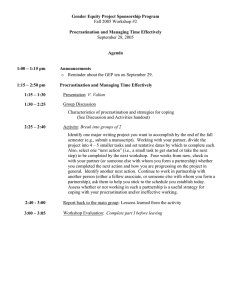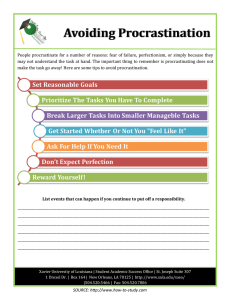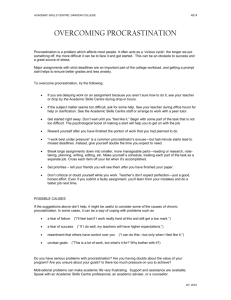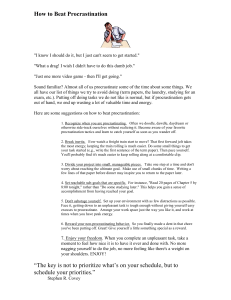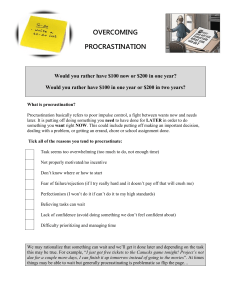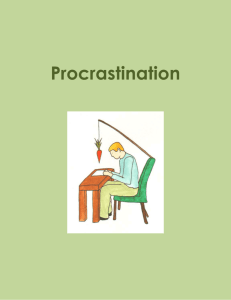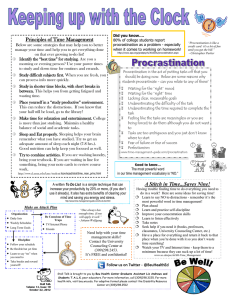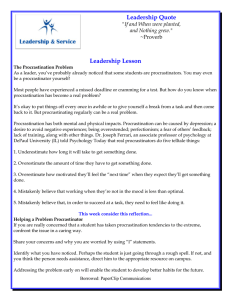28 September 2005 Gender Equity Project Colloquia and Workshops
advertisement
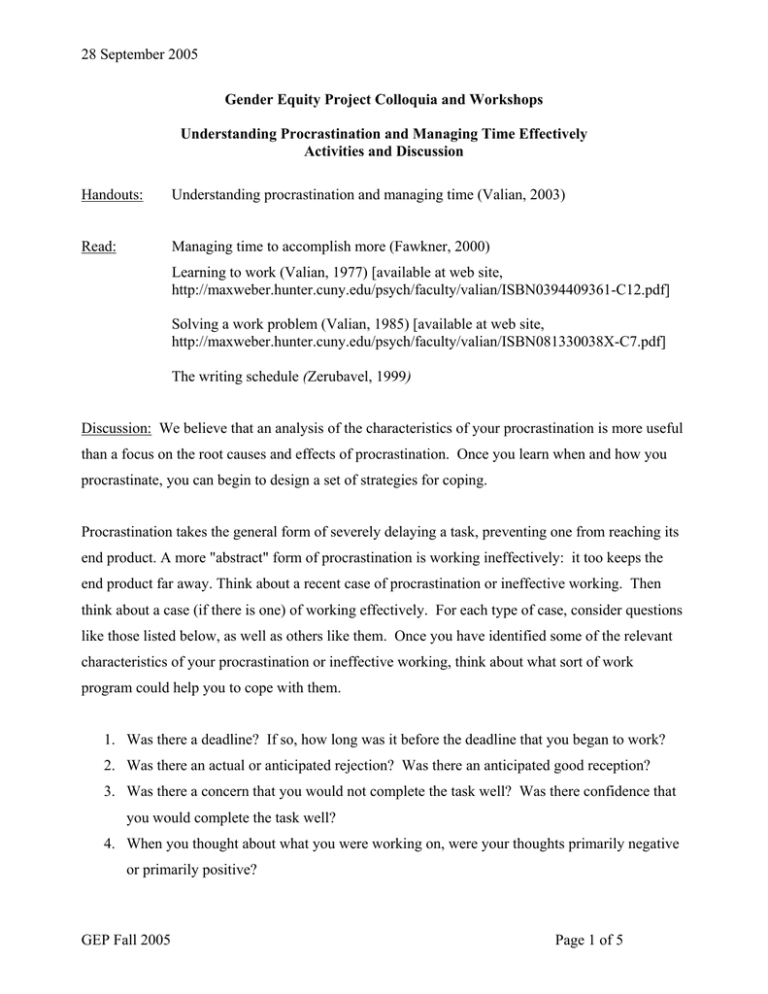
28 September 2005 Gender Equity Project Colloquia and Workshops Understanding Procrastination and Managing Time Effectively Activities and Discussion Handouts: Understanding procrastination and managing time (Valian, 2003) Read: Managing time to accomplish more (Fawkner, 2000) Learning to work (Valian, 1977) [available at web site, http://maxweber.hunter.cuny.edu/psych/faculty/valian/ISBN0394409361-C12.pdf] Solving a work problem (Valian, 1985) [available at web site, http://maxweber.hunter.cuny.edu/psych/faculty/valian/ISBN081330038X-C7.pdf] The writing schedule (Zerubavel, 1999) Discussion: We believe that an analysis of the characteristics of your procrastination is more useful than a focus on the root causes and effects of procrastination. Once you learn when and how you procrastinate, you can begin to design a set of strategies for coping. Procrastination takes the general form of severely delaying a task, preventing one from reaching its end product. A more "abstract" form of procrastination is working ineffectively: it too keeps the end product far away. Think about a recent case of procrastination or ineffective working. Then think about a case (if there is one) of working effectively. For each type of case, consider questions like those listed below, as well as others like them. Once you have identified some of the relevant characteristics of your procrastination or ineffective working, think about what sort of work program could help you to cope with them. 1. Was there a deadline? If so, how long was it before the deadline that you began to work? 2. Was there an actual or anticipated rejection? Was there an anticipated good reception? 3. Was there a concern that you would not complete the task well? Was there confidence that you would complete the task well? 4. When you thought about what you were working on, were your thoughts primarily negative or primarily positive? GEP Fall 2005 Page 1 of 5 28 September 2005 5. Did you accurately estimate how long the task would take? 6. Did you have anyone "friendly" to show the work to once you finished it? If so, what was your attitude toward that person's likely reaction? 7. Did you have the materials you needed at hand? Did you arrange your working conditions to be maximally conducive to work? 8. Did you have a plan for how you would complete the task? At the end of each work session did you know what you would do next? 9. When you made progress on the task, did you have a feeling of accomplishment? Or did you feel too-little-too-late? 10. Do you plan your work time before you actually sit down to work? Do you reserve your work time specifically as “time for work”? Activity. Identify one major writing project you want to accomplish by the end of the fall semester (e.g., submit a manuscript). Working with a partner, divide the project into 4 – 5 smaller tasks and set tentative dates by which to complete each. Also, select one “next action” (i.e., a small task to get started or take the next step) to be completed by the next workshop. At the next workshop, tell your partner (or someone else with whom you form a partnership) whether you completed the next action and how you are progressing on the project in general. Identify another next action. Continue to work in partnership with another person (either a fellow associate, or someone else with whom you form a partnership), ask them to help you stick to the schedule you establish today. Assess whether or not working in such a partnership is a useful strategy for coping with your procrastination and/or ineffective working. GEP Fall 2005 Page 2 of 5 28 September 2005 Take home exercises. Try to formulate some strategies to help ameliorate the characteristics connected to procrastination. Adapt one of the approaches offered in the reading to your own needs, or generate some ideas of your own. Imagine yourself alternatively the experimenter and the subject in an experiment. When an experiment goes wrong, you never blame the subject. Similarly, do not blame yourself if a particular strategy does not work out. Instead, you try to figure out what variables to change. Here are a few tips to help you get started. 1. Implement some version of the writing schedule suggested by Zerubavel (1999) or use Valian’s (1977) technique of writing for set amount of time every day. 2. Minimize distractions during your writing time: Turn off the ringer on your phone, shut down e-mail programs, shut your door. If necessary, put up a sign that reads “Writing in progress: Please do not disturb", “Leave me alone, I’m writing”, or whatever seems appropriate to you. 3. End a session with a clear idea of what you will work on the next time. If you think it will help, write it down. Some people like outlines; others feel imprisoned by them. An outline or checklist helps break a large task down into small ones, helps you keep track of progress and ideas, and encourages you to think about what you want to write before you actually start to write. But the outline is not your goal, only one possible means to your goal. As you go along you want to develop an overall picture and organization for what you are working on. At the beginning that might not be possible, but your aim is to know what your leading ideas are, how they fit together, what your evidence for them is, and how your pieces of evidence fit together. 4. Allow yourself to enjoy the small accomplishments associated with working steadily and consistently. GEP Fall 2005 Page 3 of 5 28 September 2005 5. Aim for a frame of mind in which you like the doer and like the doing. To reach that frame of mind you may first need to articulate all the reasons you have for liking neither the doer nor the doing (examples: you're not smart enough; you don't know enough; you're behind on everything; other people don't have so much difficulty; it's too hard; the work isn't now and won't be good enough; it isn't now and won't be important enough; it will be rejected; the reviewers are unfair and hate you; even if it's accepted it won't make a difference; no one will pay any attention to it; it will sink like a stone). Then articulate what you like about the work and what you like about working on it. What is the pleasure that the work tacitly holds? 6. Keep a log of your work for several weeks in a row. Begin to get an idea of how much time is available for your work and how much work you can fit into the time available. Your aim here is for a realistic set of goals, based on how much time you can and will devote to writing and based on how effectively you work when you are writing. References Fawkner, E. (2000). Managing time to accomplish more. Retrieved July 2003 from http://www.superperformance.com/timedomore.html A short and informal piece on understanding your time structure, making the most of your time, and properly handling multiple projects simultaneously. McKinney, M. (2004). The successful academic. Retrieved September 19, 2005 from: http://www.successfulacademic.com. Website of Clinical Psychologist Dr. Mary McKinney which provides valuable advice on how to be successful in academia as a student, researcher, and professor. Topics include time management, overcoming procrastination, teaching effectively, and successfully completing a dissertation without being discouraged or overwhelmed. Valian, V. (1977). Learning to work. In S. Ruddick & P. Daniels (Eds.), Working it out: 23 women writers, artists, scientists, and scholars talk about their lives and work (pp. 162-178). New York, NY: Pantheon Books. A personal account describing the efficient use of short periods of time, enjoying the work process (and not simply doing it for the end goal), and overcoming misconceptions and anxiety to become a better worker. GEP Fall 2005 Page 4 of 5 28 September 2005 Valian, V. (1985). Solving a work problem. In M.F. Fox (Ed.), Scholarly writing and publishing: Issues, problems, and solutions (pp. 99-110). Boulder, CO: Westview Press. Another personal account on what it means to have a work problem, the various problems and potential solutions that exist, and among other definitions, the distinction between “work” and a “job”. Valian, V. (2003). Understanding procrastination and managing time. Unpublished manuscript. Hunter College. A concise piece on handling procrastination through coping with anxiety associated with work. Also directs the reader to resources with additional tips on alleviating stress and being productive. Zerubavel, E. (1999). The writing schedule. In The clockwork muse (pp.14-35). Cambridge: Harvard University Press. An article examining in depth the importance of allocating time specifically for writing. Topics include making schedules and managing multiple projects. The article also incorporates advice from renowned authors. GEP Fall 2005 Page 5 of 5
